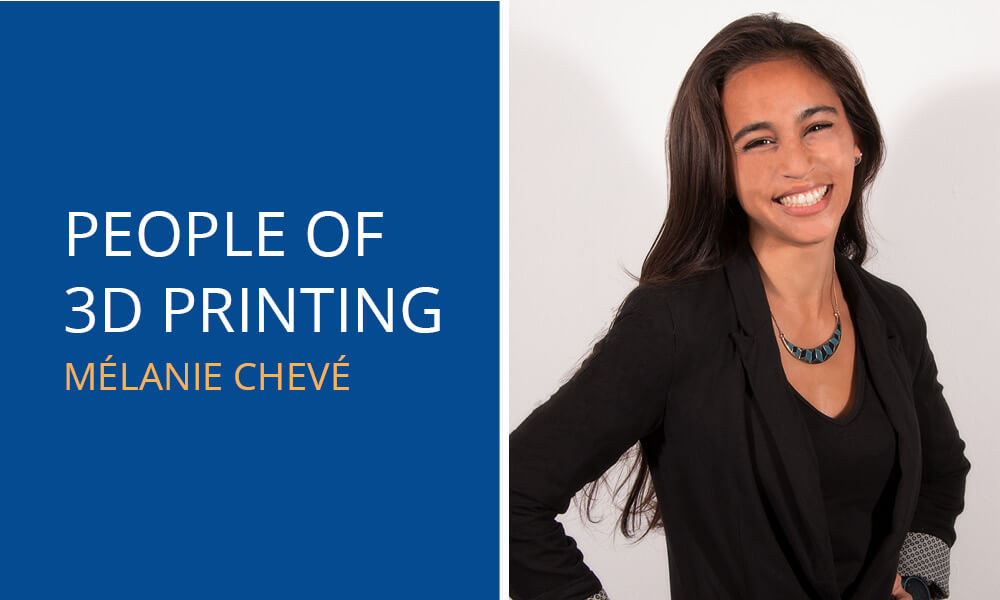People of 3D Printing: Mélanie Chevé
Posted By Lucie Gaget on Dec 7, 2020 | 0 comments
Who is Mélanie Chevé?
Meet Mélanie Chevé, 3D printing plastic Product Owner at the Renault group. Passionate about digital production technologies and oriented towards Additive Manufacturing since her career start, Mélanie explains to us how she contributes to integrating 3D printing into Automotive production processes.
Can you tell us about your academic & professional background?
I graduated from a general engineering school and carried out a master thesis in Sweden, pertaining to metal 3D printing for drawing presses. In the scope of this study, I had to redesign drawing press manufacturing methods to make use of 3D printing. The aim was to use this technology to integrate better metal sheet cooling circuits to the drawing. With the freedom of design of Additive Manufacturing, it was possible to implement these circuits and to optimize cooling fluxes.
This is how my curiosity towards this technology was born, especially in industrial fields. After this thesis, I joined a consulting company named Segula Technologies, which sent me to the Renault group. My job pertained to the deployment and structuring of their plastic 3D printing network. Following this mission, I have been hired at the Renault group to continue our work on our 3D printing factory network, but also on factory process digitalization.
What attracted you to Additive Manufacturing?
The possibility to build on traditional manufacturing methods and to rethink the way we produce. I have always been very curious about the industry field and manufacturing processes, also, 3D printing opens up new prospects on these topics.
Can you give us examples of projects you participated in at Renault?
Within this group exists centers having a strong Additive Manufacturing experience acquired throughout 20 years of use. On the other hand, there are plants that can’t rely on the knowledge or equipment required to make use of this technology. Our approach was to structure the use of 3D printing across our factory network, sharing all good practices, hardware, and design recommendations. Following this mission, we mapped the resources and means, thus to standardize the use of Additive Manufacturing. We deployed the parts we considered interesting to 3D print from one site to the others, in order to maximize gains and good applications.
What are the technologies Renault resorts to?
In terms of plastics, as these are the materials I work on, we use Fused Deposition and Laser Sintering systems, as well as HP’s Multi Jet Fusion technology. Concerning metal processes, we also resort to Fused Deposition Modeling and Selective Laser Sintering. To give you an idea, all our factories are fitted with plastic 3D printing platforms, their number varying between 3 to 13, depending on the factory size. We also have referents entitled to run 3D printers on-site, who manage demand, design, and printing.
What are the applications of these parts?
We mainly print tools and prototypes. Ultimately, we only use 3D printing to address process applications, but not for end parts users can find in their vehicle.
We use 3D printing a lot for rapid prototyping or for proves of concept (thus to certify parameters such as weight or cost-effectiveness). On the tooling side, we resort to Additive Manufacturing as a replacement means. If a part breaks and we need another one for maintenance, we might use this technology if providers can’t deliver it in sufficient delays or with under an order size we don’t want.
On our production lines, 3D Printing comes to foster ergonomics at work. We print, among others, safety equipment to avoid non-qualities on a vehicle, handles to supports operators in their job, or car door positioning jigs for instance.
What are the advantages you perceive in 3D Printing for Automotive?
The main outcome is to be able to design, manufacture, and take decisions in a flexible, fast, and local manner, with cost-reduction advantages. It is also the ability to design and iterate multiple designs, to gain independence from supplier delays.


 Connect with Google
Connect with Google Connect with Facebook
Connect with Facebook